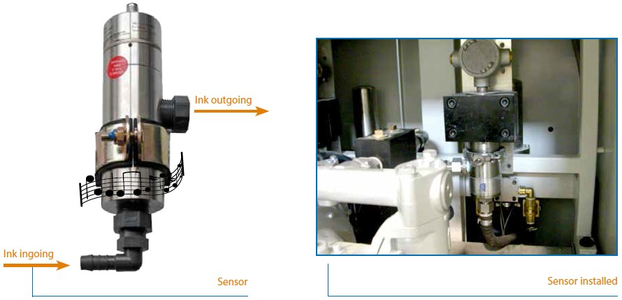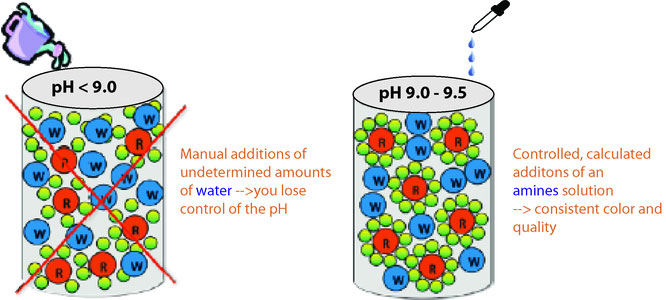COLOR|CONTROL
// Show off your Colors
- Water-based coatings and varnishes are a mixture of the several main components (including water, pigment, resin, amines, and performance enhancing additives)
- Water-based coatings at a pH between 8.5 - 9,5 will print and perform optimally
- The rate of evaporation of the amines increases as the coating temperature rises
- Stable water-based coating chemistry = controlled viscosity, stable temperature and optimal density of the coating
- Industry coating consumption studies reveal that a 1-second (Zahn cup) change in coating viscosity can produce a change in coating laydown of up to 50%.

// What happens to the printing process with a water-based coating that is maintained out-of specification?
(1) Coatings with a pH less than 8.5
The integrity of the coating formula is compromised. The stability of the coating is weakening, sludge-like deposits can be noticed in the bottom of the coating pail, the aniloxes will start to clog, plates will start to dirty, printing defects occur more often.
- Stoppages every 1500–2000 sheets/hour to clean the plates, wasting about 15 minutes of valuable printing time each time.
(2) Coatings with a pH between 8.5 to 9.5
This guarantees the optimal balance of all the ingredients confirming the water to amines ratio is within specifica-tion. The coating will dry where it should not on the printing plates or in the aniloxes. Optimum performance and efficiency of the printing process is achieved.
- With this optimal chemistry, coatings can print 5000–6000 sheets/hour without stopping for plate or anilox cleaning all the while producing exceptional quality product.
(3) Coatings with a pH higher than 9.5
The coating viscosity will be too low. Coating drying on the plates and aniloxes occurs. The dry film thickness is lower, poor print quality (runny), poor color density becomes apparent, ink emulsion problems are possible, trapping problems arise.
- Duo-Technik’s Color Management system can liberate a huge amount of “free” press time, improving the print press efficiency, creating lower overall costs while stabilizing the printing process and improving the delivered print quality.
// Stable temperature – stable coatings
Ambient press room temperatures and heat generated within the printing process cause the coating temperature to gradually increase. The warming of the coating increases the rate of evaporation of the amines, resulting in a drop in the pH, changing the viscosity and the coating density.
With a constant coating temperature, the change in viscosity and pH can be tempered, maintaining a stable coating mixture, with more consistent print results, at faster press speeds, for a longer periods of time (about 2–3 hours). The temperature is suggested to be set between 68 and 72 °F.
// Our coating cooling system is quick!
With the Coating Cooling System from Duo-Technik, overcoming a temperature difference of 15°F in less than 4 minutes is achievable. Based on our technology and installation methods, the levels of micro-foam created in the coating could be reduced. The following technical details characterize our system:
- The Coating Cooling System operates with ice cold water (about 39–43°F
- The cold water is circulated through our insulated heat exchangers (installed on each printing unit) until the individual desired ink temperature are reached.
The reason for the rapid temperature correction is a direct result of our separate coating circuit. We achieve this since we are able to circulate a high volume of coating through the heat exchanger in a short period of time.
The entire system is connected in the ink circuit as to utilize the automatic cleaning cycle of the printing press thus eliminating the need for any manual cleaning processes.
The entire system is connected in the ink circuit as to utilize the automatic cleaning cycle of the printing press thus eliminating the need for any manual cleaning processes.

// Measuring the viscosity is the best indicator of what is happening to a coating. The measured viscosity indicates when a correction is necessary!
Our Automatic Viscosity Control system incorporates an unique Intelligent Inline Sensor manufactured by a market leader. The unique inline installation provides real time, dynamic viscosity measurements while installing easily to most presses with or without automatic wash-up systems. The positioning of the viscometer "inline" (ie in the coating pathway prior to the coating metering system) is key to enabling the viscometer to adapt to the varying coating conditions intuitively, while allowing the operator to relate the coating viscosity control to the actual printing results.

Key attributes of the viscometer are:
- Maintenance free operation
- No moving parts and no mechanical seals to wear out or replace
- Can be integrated into the coating circuit directly or in a bypass circuit
- All wetted surfaces are high grade stainless steel
- Continuous measurements, not periodic time measurements
- Compatible with water-based and solvent-based coatings
- Viscosity range 1 to 1,000 Centipoints (mPa*s)
// Intelligent Software Interface
Without an intelligent software interface, a viscometer on its own is not enough for an effective viscosity control system. The software interface monitors the coating viscosity continuously and makes minute corrective addi-tions of the appropriate Adjusting Fluid to maintain the desired Viscosity set point. The measurements displayed on the touch screen can be set to match the manual viscosity cup measurement units (e.g. Ford cup 4, Zahn # 2). Additionally, Coating Cooling can be integrated and both the Viscosity and Temperature set points can be set and controlled from the main screen or a remote local screen.
// A Question of Coating Chemistry "101"
//Question:
To correct the viscosity of a water-based coating, should you just have to add water?
//Answer:
Actually although this common practice worldwide it is the wrong way to maintain the coating viscosity. Adding water with a pH around 6.5 - 7.5 (and usually overdosing) results in diluting the coating chemistry and eventually lowering of the pH below operating specifications. On short runs additions of water may be acceptable but the shelf life of the ‘returned' or unused coating” will be negatively affected.
// Without proper and ongoing viscosity control, here are some of the problems that you may experience:
- Color density from the beginning to the end of runs is not consistent, colors start to fade / wash-out
- Foaming increases (especially micro foam) requiring additions of defoamer or anti-foaming agents; too much will cause fish-eyes to appear on the printed board
- Separation of the coating (sludge begins to form on the bottom of the coating pail)
- Printing plates and aniloxes start to dirty up, print defects begin to appear
- Drying characteristics of the board slow-down, press jams or wrap-arounds may occur

// Opimizing your ink viscosity has never been easier
Duo-Technik’s Integrated Automatic viscosity control system adds minute quantities of pH adjusted water (10.5- 11.0) as required, using amines such as MEA, DMEA or the odorless AMP-95. In this way a long-term stable emulsion for the printing process with an extended shelf-life can be maintained within the operating parameters of the coating manufacturer.
Combining coating cooling, viscosity control, and an intelligent software interface (based on an in-depth under-standing of underlying basic coating chemistry) producing HQ printing results consistently at the most efficient process costs is ever so possible!
Tight viscosity control within a 0.5 second efflux cup variance will ensure;
- color consistency throughout the print run
- double digit % in coating savings compared to manual control
// Maintenance-free viscometers, pH stability and effective fast coating cooling
Whether you need a single station or a multiple station system, it is available…Same reliability, same accuracy!
How many stations do want to control, it is up to you!


// Filtering ink is often overlooked, but should never be forgotten!
Usually uncovered, the ink pail is a catch-all for all kinds of debris and contaminants. An in-line corrosion-resistant coating filter designed to remove ferrous (doctor blade wear) and non-ferrous contaminating particles. The filter using powerful rare-earth magnets housed in a conical shaped tube is designed to ensure efficient coating flow- through with little or no turbulence.
- Protect your aniloxes and printing plates
- Say good-bye to contamination
- Tool-free easy maintenance
// It is easy to maintain
Unscrew the knob, remove the cap, and the strainer and just wipe down the magnetic tube - the collected metallic particles will fall off on the rag because of the non-magnetic tube tip
NO TOOLS OR FUSSING REQUIRED!
// Guaranteed satisfaction
- Dampens coating flow surges
- Increases anilox lifetime
- Improves coating consistency
- Reduces print defects
- Improves print quality
- Removes ferrous particles from coatings
- Reduces coating clogging
- Maintains debris-free coatings
- Increases press uptime
- Easy tool-free maintenance

// Filtering ink is often overlooked, but should never be forgotten!
Usually uncovered, the ink pail is a catch-all for all kinds of debris and contaminants. An in-line corrosion-resistant coating filter designed to remove ferrous (doctor blade wear) and non-ferrous contaminating particles. The filter using powerful rare-earth magnets housed in a conical shaped tube is designed to ensure efficient coating flow- through with little or no turbulence.
- Protect your aniloxes and printing plates
- Say good-bye to contamination
- Tool-free easy maintenance
// It is easy to maintain
Unscrew the knob, remove the cap, and the strainer and just wipe down the magnetic tube - the collected metallic particles will fall off on the rag because of the non-magnetic tube tip
NO TOOLS OR FUSSING REQUIRED!
// Guaranteed satisfaction
- Dampens coating flow surges
- Increases anilox lifetime
- Improves coating consistency
- Reduces print defects
- Improves print quality
- Removes ferrous particles from coatings
- Reduces coating clogging
- Maintains debris-free coatings
- Increases press uptime
- Easy tool-free maintenance

